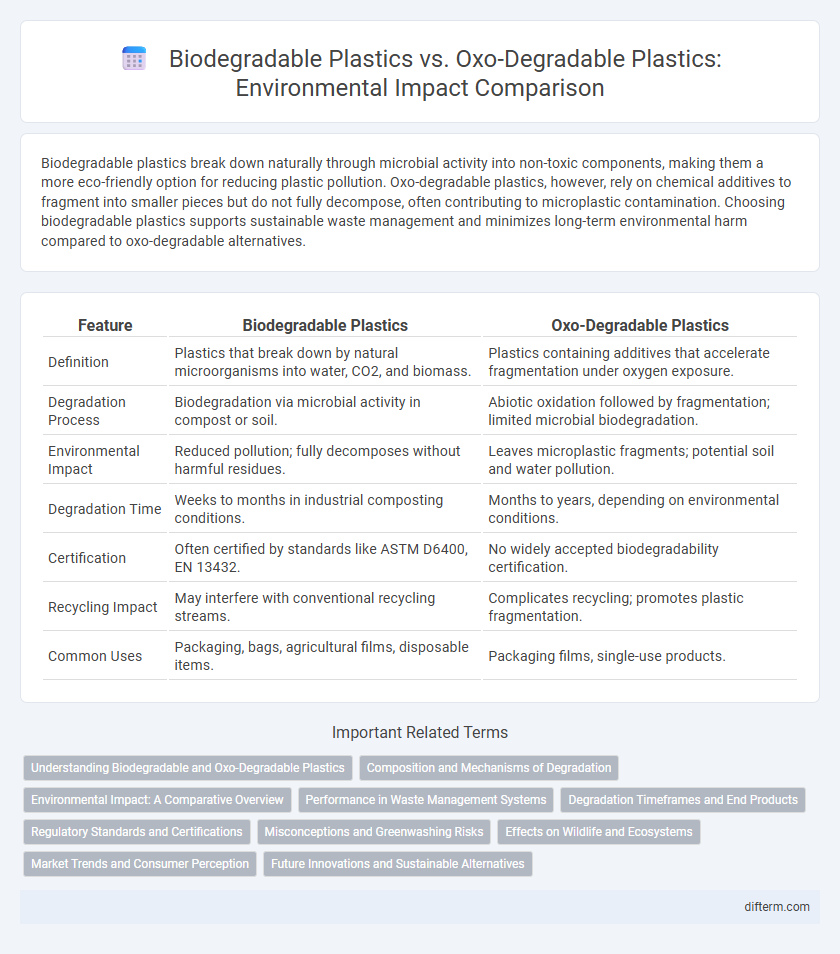Biodegradable plastics break down naturally through microbial activity into non-toxic components, making them a more eco-friendly option for reducing plastic pollution. Oxo-degradable plastics, however, rely on chemical additives to fragment into smaller pieces but do not fully decompose, often contributing to microplastic contamination. Choosing biodegradable plastics supports sustainable waste management and minimizes long-term environmental harm compared to oxo-degradable alternatives.
Table of Comparison
| Feature | Biodegradable Plastics | Oxo-Degradable Plastics |
|---|---|---|
| Definition | Plastics that break down by natural microorganisms into water, CO2, and biomass. | Plastics containing additives that accelerate fragmentation under oxygen exposure. |
| Degradation Process | Biodegradation via microbial activity in compost or soil. | Abiotic oxidation followed by fragmentation; limited microbial biodegradation. |
| Environmental Impact | Reduced pollution; fully decomposes without harmful residues. | Leaves microplastic fragments; potential soil and water pollution. |
| Degradation Time | Weeks to months in industrial composting conditions. | Months to years, depending on environmental conditions. |
| Certification | Often certified by standards like ASTM D6400, EN 13432. | No widely accepted biodegradability certification. |
| Recycling Impact | May interfere with conventional recycling streams. | Complicates recycling; promotes plastic fragmentation. |
| Common Uses | Packaging, bags, agricultural films, disposable items. | Packaging films, single-use products. |
Understanding Biodegradable and Oxo-Degradable Plastics
Biodegradable plastics break down naturally through microbial activity into water, carbon dioxide, and biomass within a specific timeframe, minimizing environmental impact. Oxo-degradable plastics contain additives that accelerate fragmentation under oxygen exposure but often persist as microplastics, posing pollution risks. Understanding these distinctions is crucial for developing sustainable alternatives that truly reduce plastic waste in ecosystems.
Composition and Mechanisms of Degradation
Biodegradable plastics are composed of natural polymers such as starch, cellulose, and polylactic acid (PLA), which microorganisms break down into water, carbon dioxide, and biomass through enzymatic action. Oxo-degradable plastics contain conventional polymers like polyethylene infused with metal salts that catalyze oxidation, causing fragmentation into microplastics under exposure to heat, light, and oxygen. The degradation mechanism of biodegradable plastics ensures complete mineralization, whereas oxo-degradable plastics undergo abiotic degradation resulting in persistent microplastic residues in the environment.
Environmental Impact: A Comparative Overview
Biodegradable plastics break down naturally into non-toxic components through microbial activity, minimizing long-term environmental harm and reducing plastic pollution. Oxo-degradable plastics fragment into microplastics under UV exposure but do not fully biodegrade, contributing to persistent environmental contamination. Studies reveal biodegradable plastics offer a more sustainable alternative by lessening soil and marine pollution and lowering carbon footprints compared to oxo-degradable counterparts.
Performance in Waste Management Systems
Biodegradable plastics break down into natural compounds through microbial activity, making them compatible with industrial composting and reducing landfill accumulation. Oxo-degradable plastics fragment into smaller pieces with the help of additives but often persist as microplastics, complicating recycling and waste separation processes. Waste management systems benefit from biodegradable plastics due to their lower environmental persistence and improved integration into organic waste streams.
Degradation Timeframes and End Products
Biodegradable plastics typically degrade within months to a few years, breaking down into water, carbon dioxide, and biomass through microbial activity, resulting in minimal environmental residue. Oxo-degradable plastics, however, fragment into microplastics over a longer time frame of several years to decades due to oxidation, which can persist in ecosystems and contribute to microplastic pollution. The distinction in degradation mechanisms and end products significantly impacts environmental sustainability and waste management strategies.
Regulatory Standards and Certifications
Biodegradable plastics are increasingly regulated under standards such as ASTM D6400 and EN 13432, which certify materials based on their ability to break down under industrial composting conditions without leaving harmful residues. Oxo-degradable plastics often fail to meet these certifications because they fragment into microplastics rather than fully biodegrading, raising concerns from environmental watchdogs and regulatory agencies. Regulatory bodies like the European Union and various environmental protection agencies are moving towards stricter guidelines, favoring certified biodegradable plastics to minimize ecological impact and ensure proper waste management.
Misconceptions and Greenwashing Risks
Biodegradable plastics break down naturally through microbial activity, whereas oxo-degradable plastics fragment into microplastics without full biodegradation, posing significant environmental hazards. A common misconception is that both types are eco-friendly, but oxo-degradable plastics contribute to long-term pollution and soil contamination. Greenwashing risks arise when manufacturers label oxo-degradable plastics as biodegradable, misleading consumers and undermining genuine sustainable efforts.
Effects on Wildlife and Ecosystems
Biodegradable plastics break down into natural substances through microbial activity, reducing long-term pollution and minimizing harmful impacts on wildlife and ecosystems. Oxo-degradable plastics fragment into microplastics that persist in the environment, posing ingestion risks to marine and terrestrial animals and disrupting food chains. The accumulation of microplastic particles from oxo-degradable plastics leads to habitat contamination and potentially toxic effects on biodiversity.
Market Trends and Consumer Perception
Biodegradable plastics are experiencing rapid market growth due to increasing consumer demand for sustainable and eco-friendly alternatives, driven by regulatory support and rising environmental awareness. Oxo-degradable plastics face declining popularity as research reveals their limited degradation and potential to contribute to microplastic pollution, leading to negative consumer perception. Industry reports highlight a shift towards biodegradable options, with significant investments in innovation and enhanced biodegradability standards shaping future market dynamics.
Future Innovations and Sustainable Alternatives
Future innovations in biodegradable plastics emphasize enzymatic and microbial enhancements that accelerate decomposition without releasing microplastics, contrasting oxo-degradable plastics which fragment into harmful residues. Sustainable alternatives focus on biopolymers derived from renewable resources like polylactic acid (PLA) and polyhydroxyalkanoates (PHA), offering complete biodegradability in industrial composting conditions. Advancements in material science aim to improve mechanical properties and reduce environmental impact, promoting circular economy principles in plastic production and disposal.
biodegradable plastics vs oxo-degradable plastics Infographic

 difterm.com
difterm.com